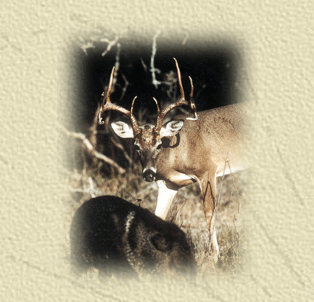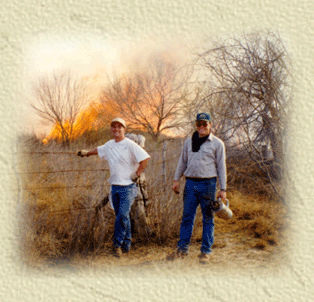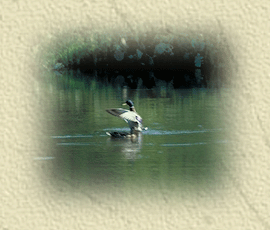Wildlife
Tax Exemption
In 1995, Texas voters approved Proposition
11, which allowed for the agricultural appraisal for land used to
manage wildlife. This allowed Texas landowners the option
of converting their current agricultural exemption to a wildlife
exemption if certain conditions were met.
The
Tax Code, defines wildlife management
as:
Actively using land that at the time the
wildlife management began was appraised as qualified open-space
land under this subchapter in at least three of the following
ways to propagate a sustaining breeding, migrating, or wintering
population of indigenous wild animals for human use, including
food, medicine, or recreation:
(A) habitat control;
(B) erosion control;
(C) predator
control;
(D) providing supplemental supplies of
water;
(E) providing supplemental supplies of
food;
(F) providing
shelters; and
(G) making census counts to determine
population.

Qualifying
for the Wildlife Tax Exemption
1)
Land must be qualified for Agricultural use at the time the owner changes use to
wildlife management use.
This qualification is purely technical and is not related to the
land's actual use to manage wildlife. In other words, the land must have been
qualified and appraised as agricultural land during the year
before the year the owner changes to the wildlife management
use. For example, an owner who wishes to qualify for wildlife
management use in 1996 must be able to show the land was
qualified for and appraised as agricultural land in 1995.
2) Land must be used to generate a sustaining breeding,
migrating, or wintering population of indigenous wild animals.
An indigenous animal is one that is native to
Texas.
Land may qualify for wildlife management use
if it is instrumental in supporting a sustaining breeding,
migrating or wintering population. A group of animals need not
permanently live on the land, provided they regularly migrate
across the land or seasonally live there.
A sustaining breeding population is a
group of indigenous wild animals that is large enough to live
independently over several generations. This definition implies
that the population will not die out because it produces enough
animals to continue as a viable group.
A migrating population of indigenous
wild animals is a group of animals moving between seasonal
ranges.
A wintering population of indigenous wild animals
is a group of animals living on its winter range.
The law requires an owner to propagate the
wildlife population for human use. Human use may include food,
medicine or recreation.
A recreational use may be either active or
passive and may include any type of use for pleasure or sport.
Bird watching, hiking, hunting, photography and other
non-passive recreational or hobby-type activities are qualifying
recreational uses. The owner's passive enjoyment in owning the
land and managing it for wildlife also is a qualifying
recreational use.
3) Is the land used for
three or more of the following
activities?
Meeting three of the possible seven management
activities should be described in detail in the properties Wildlife
Management Plan. This will also show
evidence of the land's primary Use and Degree of Intensity that
are described below.
· Habitat Control (Habitat
Management). A wild animal's habitat is its surroundings
as a whole, including plants, ground cover, shelter and other
animals on the land. Habitat control or habitat management means
actively using the land to create or promote an environment that
is beneficial to wildlife on the land.
· Erosion Control. Any active
practice that attempts to reduce or keep soil erosion to a
minimum for the benefit of wildlife is erosion control.
· Predator Control (Predator
Management). This term means practices intended to
manage the population of predators to benefit the owner's target
wildlife population. Predator control is usually not necessary
unless the number of predators is harmful to the desired
wildlife population.
· Providing Supplemental Supplies of
Water. Natural water exists in all wildlife
environments. Supplemental water is provided when the owner
actively provides water in addition to the natural sources.
· Providing Supplemental Supplies of
Food. Most wildlife environments have some natural food.
An owner supplies supplemental food by providing food or
nutrition in addition to the level naturally produced on the
land.
· Providing Shelter. This term
means actively creating or maintaining vegetation or artifical
structures that provide shelter from the weather, nesting and
breeding sites or "escape cover" from enemies.
· Making Census Counts to Determine
Population.
Census counts are periodic surveys and inventories to determine
the number, composition or other relevant information about a
wildlife population to measure if the current wildlife
management practices are serving the targeted species.
4) Primary Use
The law requires agriculture
to be the primary
use of the land. This requirement is particularly
important for land used to manage wildlife. For example, land
devoted to wildlife management can be used as a residence for
the owner, but the land will not qualify if residential use and
not wildlife management is the land's primary use. An
appraiser should consider the following:
· Is the owner implementing
an active, written, wildlife management plan that shows the
owner is engaging in activities necessary to preserve a
sustaining breeding population on the land? While the law does
not require an owner to have a management plan, a plan is clear evidence of
the owner's use of the land primarily for wildlife management. A
good plan will usually list wildlife management activities with
the appropriate seasons and/or sequence of events.
· Do the owner's management practices
emphasize managing the population to ensure its continued
existence over another use of the land?
· Has the owner engaged in the wildlife
management practices necessary to sustain and encourage the
population?
5) Degree of Intensity for Wildlife Management Use
The degree of intensity standard for wildlife
management land is determined in the same way as other
agricultural uses. Wildlife management land usually requires a
management of the land that encourages long-term maintenance of
the population.
Because wildlife management activities are
elements of the degree of intensity determination, an owner must
be engaging in three of seven activities to the degree of
intensity typical for the area.

Wildlife Management
Activities and Practices
A wild animal's habitat is its surroundings
as a whole, including plants, ground cover, shelter and other
animals on the land. Habitat control or habitat management means
actively using the land to create or promote an environment that
benefits wildlife on the land.
Activities that contribute to habitat control
or management include:
·
Grazing management
· Prescribed burning
· Range enhancement
· Brush management
· Forest management
· Riparian management and improvement
· Wetland improvements
· Habitat protection for species of concern
· Managing native, exotic and feral species
Any active practice that attempts to reduce
or keep soil erosion to a minimum for wild animals' benefit is
erosion control. Some erosion control practices include:
·
Pond construction
· Gully shaping
· Streamside, pond and wetland revegetation
· Establishing native plants
· Dike, levee construction or management
· Water diversion.
This term refers to practices intended to
manage the population of predators to benefit the owner's target
wildlife population. Predator control is usually not necessary
unless the number of predators is harmful to the desired
wildlife population. Predator control and management should not
be counted as one of the seven wildlife management activities
necessary to qualify for agricultural use appraisal unless it is
part of a comprehensive wildlife management scheme or plan. Some
types of predator management and/or control are:
· Mammal predator control
· Fire ant control
· Brown-headed cowbird control
· Grackle or starling control.
Natural water exists in all wildlife
environments. Supplemental water is provided when the owner
actively provides water in addition to the natural sources. This
category of wildlife management activity includes providing
supplemental water in habitats where water is limited or
redesigning water sources to increase its availability to
wildlife. Wildlife water developments are in addition to those
sources already available to livestock and may require
protection from livestock. Some examples of recommended
practices include:
·
Marsh or wetland restoration or
development
· Managing well, trough and windmill
overflow
· Spring development and/or improvements.
Most wildlife environments have some natural
food. An owner supplies supplemental food by providing food or
nutrition in addition to the level naturally produced on the
land. Grazing Management, Prescribed Burning and Range
Improvement can be used to provide supplemental food.
Other ways to
provide supplemental food include:
·
Food plots
· Feeder and mineral supplements
· Managing tame pasture, old fields and
croplands.
This term means actively creating or
maintaining vegetation or artificial structures that provide
shelter from the weather, nesting and breeding sites or
"escape cover" from enemies. The best shelter for
wildlife can be provided by a well managed habitat. Some
practices listed below provide types of shelter that may be
unavailable in the habitat:
·
Installing nest boxes and bat boxes
· Brush piles and slash retention
· Managing fence lines
· Managing hay meadow, pasture or cropland
· Half-cutting trees and shrubs
· Establishing woody plants and shrubs
· Developing natural cavities and snags.
Census counts are periodic surveys and
inventories to determine the number, composition or other
relevant information about a wildlife population to measure if
the current wildlife management practices are serving the
targeted species. Such surveys also help evaluate the management
plan's goals and practices. Specifically, this activity
estimates species numbers, annual population trends, density or
age structure using accepted survey techniques. Annual results
should be recorded as evidence of completing this practice. The
survey techniques and intensity listed below should be
appropriate to the species counted:
· Spotlight counting
· Aerial counts
· Daylight wildlife composition counts
· Harvest data collection and record keeping
· Browse utilization surveys
· Census and monitoring
endangered wildlife
· Census and monitoring of nongame wildlife
species